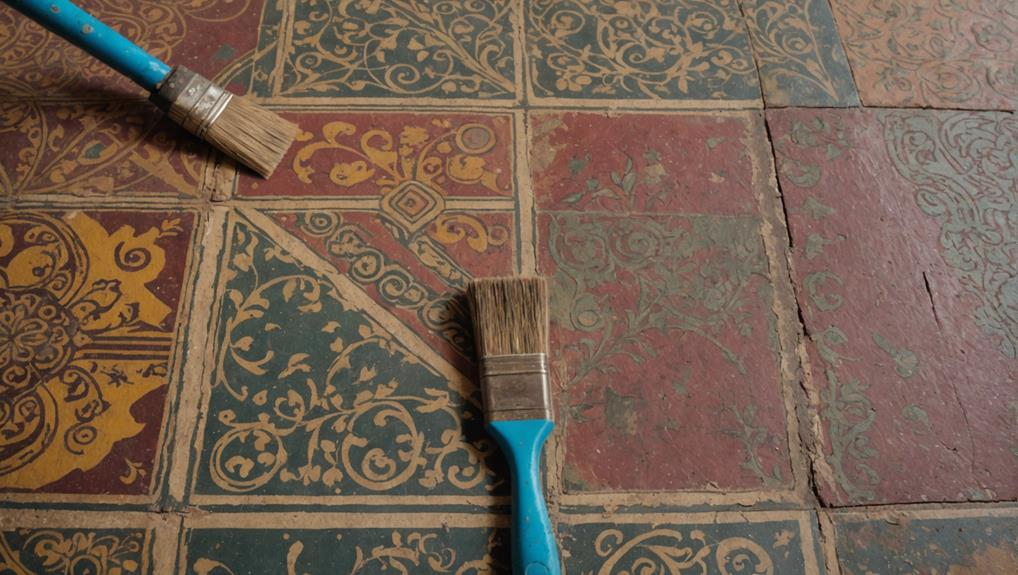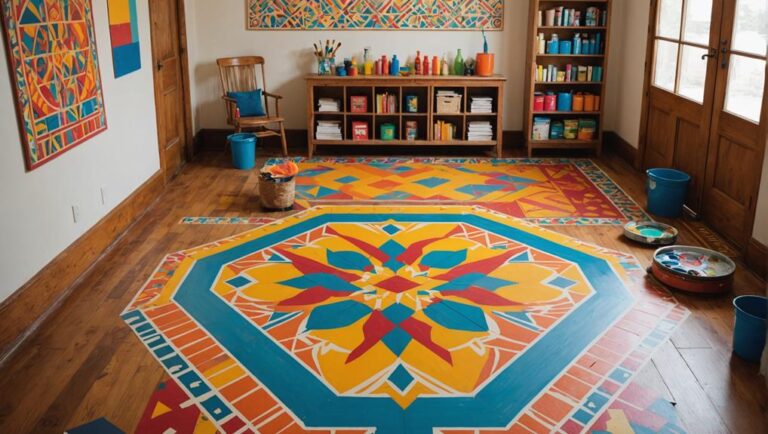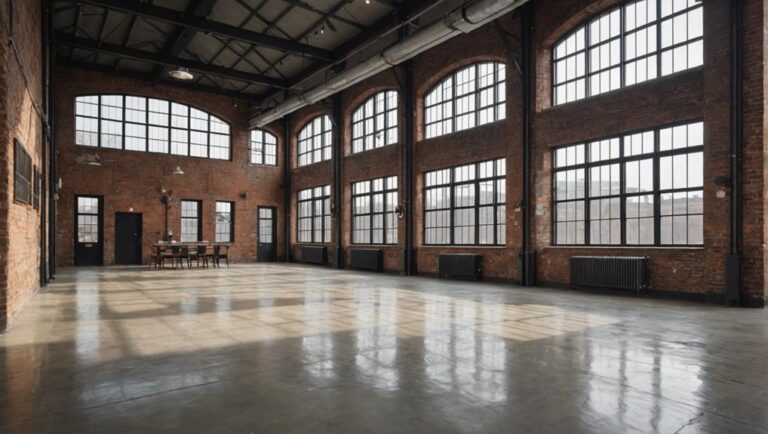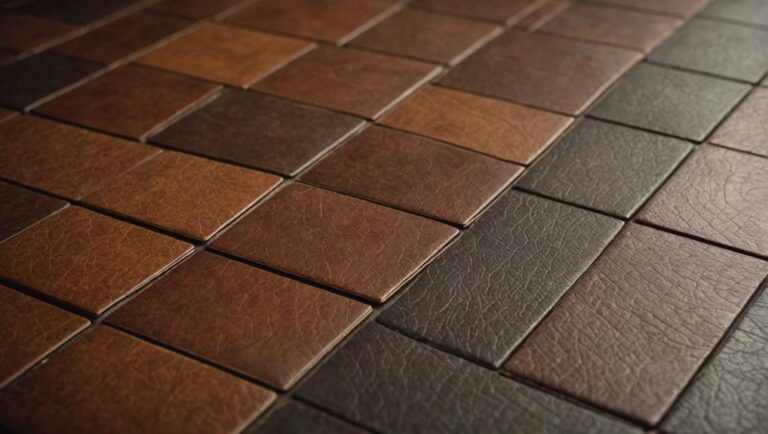Restoring color in faded linoleum floors involves a few essential steps. Start by cleaning the surface thoroughly with a damp mop and mild soap to remove dirt and prevent scratches. Choose a suitable color restorer, ensuring it's compatible with linoleum. Apply the product evenly using a microfiber mop for large areas, and follow the manufacturer's drying times. After restoration, maintain vibrancy by regularly sweeping and using a pH-neutral cleaner. Consider adding UV protection with window treatments to prevent further fading. By implementing these techniques, you'll enhance your floors' appearance and longevity; more methods are available for further improvement.
Understanding Linoleum Flooring
Linoleum flooring, often recognized for its durability and eco-friendliness, is a popular choice in both residential and commercial spaces. Its history dates back to the mid-19th century, when it was first created from natural materials like linseed oil, cork dust, and wood flour. This composition not only contributes to its sustainable reputation but also enhances its longevity and resilience against wear and tear.
When you consider flooring benefits, linoleum stands out due to its low maintenance requirements and resistance to stains and scratches. Unlike other flooring options, linoleum is inherently antimicrobial, making it a safe choice for spaces that require high hygiene standards, such as kitchens and healthcare facilities. The flooring can also be installed over various substrates, providing versatility in application.
Additionally, linoleum offers a variety of colors and patterns, allowing you to customize your space while maintaining safety and functionality. Its ability to maintain its appearance over time, coupled with proper care, makes it a cost-effective investment.
It's important to note that linoleum is biodegradable and can be recycled, aligning with eco-conscious choices. When cared for properly, it can last decades, reducing the need for frequent replacements. By understanding linoleum flooring's history and its myriad benefits, you can make an informed decision that prioritizes both safety and aesthetic appeal in your environment.
Common Causes of Fading
Over time, various factors can contribute to the fading of linoleum floors, diminishing their vibrant appearance. One of the primary causes is sunlight exposure. Ultraviolet (UV) rays from direct sunlight can break down the pigments in the linoleum, leading to discoloration and a washed-out look. If your floors are subjected to prolonged sunlight without adequate protection, you may notice significant fading over time.
Another essential factor is the occurrence of chemical reactions. Certain cleaning agents, particularly those containing bleach or ammonia, can react adversely with the materials in linoleum. These reactions may not only cause discoloration but can also degrade the floor's surface, making it more susceptible to fading. It's vital to use pH-neutral cleaning solutions specifically designed for linoleum to avoid these detrimental effects.
In addition, wear and tear from foot traffic can exacerbate fading. As the surface wears down, the underlying layers may become exposed, leading to a dull appearance. If your linoleum is located in high-traffic areas, consider placing rugs or mats to help reduce direct wear.
Lastly, humidity and temperature fluctuations in your home can also affect linoleum. Excessive moisture can lead to mold growth, while extreme heat can warp the material. Both scenarios can contribute to uneven fading. By understanding these common causes of fading, you can take proactive measures to maintain your linoleum floors and preserve their original color.
Preparing Your Floors for Restoration
Before you start restoring your faded linoleum floors, it's crucial to clear the area of any furniture and obstructions. Next, inspect the surface for any damage, as this will determine the necessary repairs. Finally, select the appropriate restoration products that will effectively rejuvenate the color and finish of your floors.
Clear the Area
To effectively restore the color of your faded linoleum floors, you'll need to start by clearing the area of any furniture, rugs, or obstacles. This step is essential for ensuring a safe and efficient restoration process. Proper floor decluttering not only allows you to work freely but also helps prevent any damage to your belongings during the restoration.
Here are some floor decluttering tips to take into account:
- Remove all furniture: Move tables, chairs, and other items to an adjacent room or an outdoor space.
- Take up rugs and mats: These can trap dirt and hinder restoration efforts, so roll them up and store them safely.
- Organize tools and supplies: Have everything you need ready, including cleaning solutions and applicators, to streamline your workflow.
- Ensure adequate lighting: A well-lit workspace helps you see any problem areas that need attention.
Inspect for Damage
Once you've cleared the area, it's important to verify your linoleum floors for any damage that could affect the restoration process. Start by examining the surface for scratches, dents, or tears. These imperfections may interfere with the application of color preservation products. Pay special attention to seams and edges, as they are often more susceptible to damage.
Next, check for signs of water damage or mold, which can compromise the integrity of the floor materials. If you notice any discoloration or swelling, it might indicate deeper issues that require repair before proceeding with restoration. Take note of any areas where the linoleum has lifted or separated from the subfloor, as these should be addressed to verify a smooth, even surface.
Choose Restoration Products
Selecting the right restoration products is crucial for effectively rejuvenating your faded linoleum floors. You'll want to focus on products that guarantee safety while maintaining product effectiveness and achieving the best color matching. Here are some key factors to take into account when choosing your restoration products:
- Type of Finish: Look for finishes specifically designed for linoleum to guarantee compatibility and durability.
- Color Restoration Agents: Select products that offer a range of color options to match your original flooring shade accurately.
- Non-toxic Formulations: Prioritize eco-friendly and non-toxic products to safeguard your health and the environment.
- Application Tools: Invest in quality applicators, such as mop pads or brushes, that will help you achieve an even and smooth application.
Before making a purchase, read reviews and verify that the products have been tested for effectiveness on linoleum surfaces. By carefully selecting the right restoration products, you can enhance your floors' appearance while guaranteeing a safe and effective restoration process.
Cleaning Techniques for Linoleum
When it comes to maintaining the vibrancy of linoleum floors, effective cleaning techniques play a crucial role. You'll want to choose the right cleaning solutions to guarantee your floor care regimen is safe and effective. Begin by sweeping or vacuuming to remove dirt and debris. This prevents scratches during the mopping process.
Next, consider using a damp mop with a solution specifically designed for linoleum. Avoid harsh chemicals, as they can strip the floor's finish. A mixture of warm water and a few drops of mild dish soap works well. For tougher stains, a paste made from baking soda and water can gently lift grime without damaging the surface.
Below is a helpful table summarizing recommended cleaning techniques:
| Cleaning Technique | Description |
|---|---|
| Sweeping or Vacuuming | Remove loose dirt and debris |
| Damp Mopping | Use a cloth mop with warm water & soap |
| Spot Cleaning | Apply a baking soda paste for tough stains |
| Drying | Air dry or use a clean, dry mop |
| Regular Maintenance | Clean weekly to maintain appearance |
Applying Color Restorers
When restoring color to your faded linoleum floors, selecting the right color restorer is essential for achieving ideal results. You'll need to understand various application techniques to guarantee even coverage and longevity of the finish. Additionally, proper maintenance after restoration will help preserve the vibrancy of your floors over time.
Choosing the Right Product
Choosing the right product for applying color restorers can greatly impact the outcome of your faded linoleum floors. When selecting a color restorer, it's crucial to take into account several factors that guarantee safety and effectiveness. You'll want to evaluate product reviews to find options that have proven results, and also look into the available color choices to match your flooring.
Here are some key points to keep in mind:
- Compatibility: Verify the product is suitable for linoleum surfaces.
- Safety: Choose non-toxic formulas to protect your health and the environment.
- Ease of Use: Look for products that come with clear instructions for application.
- Durability: Select a color restorer that promises long-lasting results to avoid frequent reapplications.
Do thorough research before purchasing. Read customer feedback to gauge satisfaction levels and effectiveness. This way, you'll not only restore the color of your linoleum floors but also guarantee a safe and successful application process. Remember, investing time in finding the right product will lead to a more satisfying restoration experience.
Application Techniques Explained
Achieving a successful restoration of faded linoleum floors hinges on the application techniques employed. To begin, guarantee the workspace is well-ventilated and that you're wearing protective gear, such as gloves and a mask. This is essential for your safety when working with color restoration products.
Next, select the appropriate application method for the chosen color restorer. A microfiber mop is often ideal for large areas, allowing for even distribution without excess product. If you're tackling smaller spots, a soft cloth or sponge can provide more control. Always follow the manufacturer's instructions regarding dilution and application techniques.
Before applying, test the product on a hidden section of the floor to verify compatibility and desired results. When applying the color restorer, work in sections to maintain a wet edge, preventing streaks. Avoid over-saturating the floor; a thin, even coat is preferable.
Lastly, allow sufficient drying time as recommended by the manufacturer. Proper application not only enhances the floor's appearance but also guarantees the longevity of your restoration efforts. By adhering to these techniques, you'll achieve a vibrant finish while prioritizing safety throughout the process.
Maintenance After Restoration
Maintaining the vibrancy of your newly restored linoleum floors is essential for long-lasting results. To guarantee your floors remain in top condition, implement routine upkeep and protective measures that safeguard against wear and tear. Here are some key practices to follow:
- Regular Cleaning: Use a soft broom or vacuum regularly to remove dirt and debris.
- Mopping: Damp mop with a pH-neutral cleaner to keep the surface clean without causing damage.
- Avoid Harsh Chemicals: Steer clear of abrasive cleaners and solvents that can strip color and finish.
- Area Rugs: Place rugs in high-traffic areas to minimize scuff marks and wear.
Preventative Care for Longevity
To guarantee the longevity of your linoleum floors, implementing a regular maintenance routine is essential. This routine should include preventative cleaning practices that help preserve the floor's color and integrity. Start by sweeping or vacuuming your floors regularly to remove dirt and debris, which can cause scratches and dullness over time.
Consider using a damp mop with a pH-neutral cleaner specifically designed for linoleum. Avoid harsh chemicals, as these can damage the protective layer and lead to premature fading. It's also vital to spot clean spills immediately to prevent staining, which can compromise the floor's appearance and longevity.
Another important aspect of preventative care is sunlight protection. Ultraviolet (UV) rays can cause significant fading over time, so it's advisable to use window treatments like curtains or blinds to shield your floors from direct sunlight. Additionally, consider placing area rugs or mats in high-traffic areas to minimize wear and tear.
If you notice your linoleum starting to fade despite your efforts, consider applying a linoleum floor polish periodically. This can help restore some of the lost vibrancy while adding an extra layer of protection against scratches and scuffs.
Frequently Asked Questions
Can I Restore Color to Any Type of Linoleum?
Did you know that over 80% of linoleum floors lose their vibrancy over time? You can restore color to many types of linoleum using various color restoration techniques. However, results can vary based on the material's condition and age. Always follow linoleum maintenance tips to prolong its life and appearance. For best results, test any restoration method in a small area first to guarantee safety and suitability for your specific flooring.
How Long Does the Restoration Process Take?
The restoration process typically takes a few hours to a couple of days, depending on the techniques you use and the floor's condition. You'll want to follow proper restoration techniques, which can include cleaning, dyeing, or sealing. To guarantee safety, always use non-toxic products and maintain good ventilation. After restoration, regular maintenance tips like gentle cleaning and avoiding harsh chemicals can help prolong the results and keep your floors looking vibrant.
Are There Eco-Friendly Options for Color Restoration?
When it comes to eco-friendly options for color restoration, you're in luck. Using natural dyes derived from plants can be a game changer. These dyes not only bring life back to your surfaces but also align with your desire for sustainable products. Plus, they're generally safer for both you and the environment. By choosing these alternatives, you're not just restoring color; you're making a responsible choice that benefits your home and the planet.
Will Restoring Color Damage My Linoleum Floor?
Restoring color can raise concerns about potential damage to your linoleum floor. If you use appropriate restoration techniques, you're unlikely to harm the surface. It's essential to choose methods specifically designed for linoleum to prevent further color fading or deterioration. Always test any product in a small area first to guarantee compatibility. By following safety guidelines and manufacturer instructions, you can effectively restore your floor's appearance without risking damage.
How Often Should I Restore Color to My Linoleum Floors?
You should restore color to your linoleum floors based on frequency guidelines that consider foot traffic and exposure to sunlight. Typically, every 1 to 3 years is recommended, but you might need to adjust based on your specific conditions. Regular maintenance tips include cleaning the surface thoroughly before application and checking for wear. This approach guarantees longevity while minimizing potential damage, keeping your floors looking vibrant and safe for your household.




